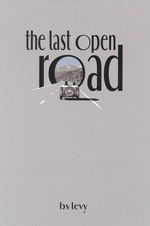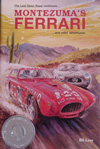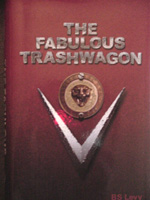A Review by Pete Vack
December 11th, 2002
To purchase from VelocePress
VelocePress.com.
The words Biggest and Best are tossed out all too frequently without meaning. But most certainly both descriptions apply to the three automotive works of fiction written by Burt Levy. It is a trilogy that begins with The Last Open Road, (after a run of 30,000 copies, it is now in its fifth printing!!) continues with Montezuma’s Ferrari, and most recently, The Fabulous Trashwagon. In the admittedly sad world of automotive fiction, Levy’s well-written and often hilarious work is head and shoulders above all others (including Stand on It), and certainly compares well with most other contemporary non-automotive fiction. In their sheer size, depth, accuracy and excellence, Levy’s works constitute an automotive event, which is why we are reviewing them here. His books have garnered glowing reviews everywhere, including the non-automotive press. It matters not that there is little about Italian cars in his books; whether our cars breathe through S.U.s or Webers, Levy defines the human condition which affects us all.

Living with Palumbo
The key to enjoying all three volumes is to be able to slip into the time-space continuum slot of Buddy Palumbo---and like it. Because with over 1282 pages to go, (and more to come) it’s gonna be a long haul.
Fortunately, Buddy proves to be a great companion. Growing up in New Jersey, the son of a chemical plant foreman, Palumbo graduates from high school in 1952 with only the dismal prospect of following in his father’s footsteps at the plant. He quits, gets a job at a local Sinclair gas station, and finds that he has been endowed with a natural mechanical ability (although being modest, he would be the last person to admit it). Enter Jag owner Big Ed Baumstein, rich kid Cal Carrington, MG owner Carson Flegley, and girlfriend Julie Finzio, characters who will accompany Buddy through his adventures. Palumbo soon finds himself as the chief pit crew and mechanic for Big Ed, whose desire to race his XK120 is greater than his talent to do so. Taken together, the three volumes start with the events of 1952 and end with the tragic 1955 season.
Palumbo is not the larger-than-life character usually associated with adventure novels. Levy explains… "I needed a narrator who was into the scene and knew what was going on…plus I liked the old notion of a working class hero. And, at least in my stories, you don’t necessarily have to do great and heroic things to be a hero. All you have to do is the right thing.."
Characters and Events
Levy skillfully weaves Palumbo and his cronies into a rich tapestry of events, combining historical personalities with his fictional characters. Like the policital fiction of Primary Colors, Levy uses fiction to tell the truth. Levy recreates the early days of sports car racing, with detailed descriptions of Bridgehampton, Thompson, Elkhart Lake and Watkins Glen, and the Mexican Panamericana. Here Levy has got it down to a science, 
fielding the history of the events, cars and drivers with consummate, enjoyable accuracy. With The Last Open Road, using Buddy as a the narrator, Levy takes a critical aim at the "rich snobs" of the SCCA (thinly disguised as the "S.C.M.A." ) who sought to control sportscar racing and keep it on an amateur basis. There doesn’t seem to be a likable member on the entire board, and with every race Levy gets a chance to twist the knife. In Montezuma’s Ferrari, Palumbo co-pilots a Ferrari driven by a local hero in the Panamericana. Palumbo then continues his travels through the East Coast American racing scene, introducing the S.A.C. Airforce Base races. The Fabulous Trashwagon deals with Palumbo’s efforts to create a racecar, aptly named Trashwagon by the established snobs of the S.C.M.A., and is surely a take-off on the Ol’ Yaller, a more than ugly west coast special that ran away from Ferraris.
Readers are welcome to participate in the great guessing game of who’s who in the book, but are reminded that while Levy has some specific people in mind, most of the fictional characters are composites of several individuals. Still, it’s fun to try to associate historical characters with the wide variety of fictional figures Levy has created.
An unlikely racing novel
Twelve hundred eighty two pages can’t be just about cars and racing. Levy’s goal was "..to paint a picture of a fifties America that seems almost unrecognizable today," he says. " We often look back on the fifties as a pretty dimbulb generation, but now I see that it may well have been the last truly innocent and confident generation this country will ever see." Unlike most automotive fiction, Levy takes Palumbo through a variety of social minefields. 
Politically, Palumbo is somewhat naïve and uninterested, but wonders about Senator McCarthy and his nasty business. At the same time, Palumbo drops in on the beat generation in Greenwich Village and learns that the far left is just as full of bs as the far right. As a lapsed Catholic, he faces a moral dilemma when his unwed sister becomes pregnant. Levy’s not afraid to include real life social and religious views along the way—most unusual for any automotive fiction. And some things never change---most of us can painfully relate to Palumbo’s relationship with Julie, as he tries to balance his passion for cars and racing with the responsibilities of a husband and father.
Criticism
Some will find the books—any one of them—too long. Buddy’s style gets stale after a few hundred pages. Some chapters could have been edited or combined with others without any negative effect.
It may be said that Levy has merely taken racing history as we all know it and created a book around it, but on the other hand, has done it with the skill and grace of a good novelist that few others could muster. He also spent a great deal of time interviewing drivers of the era such as John Fitch, Phil Hill, the late Phil Walters and Fred Wacker, all of whom thoroughly enjoyed Levy’s books.
Levy has found a surprising amount of interest in the 14-21 year old age groups, but Palumbo is from a different age, a simpler, gentler one without pc's and cellphones and cars that need a computer to bleed the brakes, and the pace may not appeal to those with a daily diet of PlayStation.
Although very accurate in most respects, Levy has (knowingly) taken a few liberties with the facts, which may cause some confusion. The most jarring of which is the use of chin spoilers to negate front end lift at Bonneville in 1954. Levy admits that while he’s got the wrong place and the wrong time, he wanted to demonstrate the beginnings of aerodynamic aids in a manner which would be understandable to non-racecar fans.
But the failings are not fatal by any means. After the last page, the characters linger satisfyingly in the mind, and one looks forward to the next chapter or book. It’s winter, the garage is cold, and Speed Channel (aka NASCARvision) is a continuing disappointment. A good time for the likes of Buddy Palumbo.